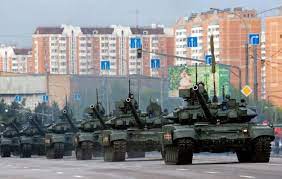Russia Withdrew From Treaty Of Conventional Armed Forces In Europe:

Russia formally withdrew from the Treaty of Conventional Armed Forces in Europe (CFE) recently.
- Treaty of Conventional Armed Forces in Europe (CFE) Negotiated during the final years of the Cold War and signed a year after the fall of the Berlin Wall, CFE placed limits on the deployment of military equipment to maintain military balance between North Atlantic Treaty Organization (NATO) and the then-Warsaw Pact countries.
- Its purpose was to stop Cold War rivals from building up forces that could be used in a swift assault.
- Twenty-two member states of the two military alliances, NATO and the Warsaw Pact came together in Paris on November 19, 1990, to sign the agreement.
- It finally entered into force on November 9, 1992. The Warsaw Pact by this time had disintegrated, and its treaty obligations were consequently passed to the pact’s successor states.
- Specifically, the Treaty required NATO and Warsaw Pact states to have in total no more than 40,000 battle tanks, 60,000 armoured combat vehicles, 40,000 pieces of artillery, 13,600 combat aircraft, and 4,000 attack helicopters on the whole territory of the respective alliances.
- To reach these targets, the CFE state parties destroyed in subsequent years more than 50,000 weapons systems.
- These steps were supervised under a treaty compliance mechanism requiring information sharing and reciprocal inspections.
- Moreover, the scope of the treaty was soon widened to cover troop numbers. The 1992 follow-up agreement known as the CFE-1A arranged limits on the level of military personnel.
- Meeting at the Istanbul summit of the Organization for Security and Co-operation in Europe (OSCE), CFE Treaty partners finally agreed, on 19 November 1999, on an updated and modified arrangement: the Adapted CFE Treaty.
- A major change was that limitations on conventional weapon systems were no longer aligned to two “blocs” but to the territorial borders of individual states.
- Russia suspended its participation in the treaty in 2007 and halted active participation in 2015.




